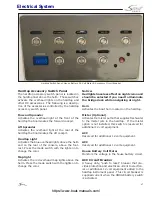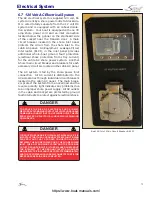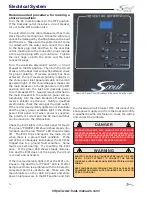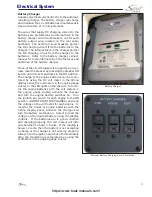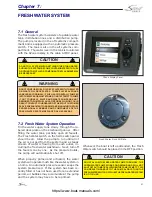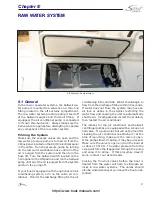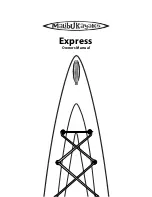
80
Electrical System
6.8 Bonding System
& Galvanic Isolator
Your boat is equipped with a bonding system that
interconnects all underwater hardware and thru-
hull fittings to ensure that they are of the same
electrical potential. Anodes are attached to the
bonding system at the trim tabs and engines.
The anodes deteriorate before the other metals,
thereby protecting the underwater metals from
galvanic corrosion or stray electrical current.
Since the anodes are sacrificial, it is important to
monitor them and replace them when they have
deteriorated to 50 - 75% of their original size. The
bonding system is connected to the DC ground
and the earth ground wire for the AC electrical
system. It provides a path for dangerous short
circuits in the AC electrical system to the safety
earth ground in the event of a fault in the shore
earth ground connection and when the boat is
away from the dock.
When the boat is connected to shore power at a
marina or city dock, all boats connected to shore
power are connected to a common shore safety
earth ground connection. This circuit provides
essential protection against electrical shock from
faults or short circuits in AC equipment and, unfor-
tunately, provides a path for low voltage galvanic
current to flow between the bonding system of
other boats in the circuit. If one or more of the
boats in the circuit has a stray current electrical
problem or is not equipped with proper galvanic
protection, it will seek protection from your boat’s
bonding system through the safety ground circuit.
This could cause accelerated deterioration of the
anodes and/or severe damage to the underwater
hardware. To prevent damage from other boats
in the circuit, a galvanic isolator is installed in
the shore ground circuit that isolates your boat’s
bonding system from the other boats. It prevents
the flow of low voltage galvanic current while still
providing a path for dangerous short circuit cur-
rents in the AC system to the shore safety ground.
6.9 Electrical System Maintenance
DC Electrical System Maintenance
At least once a year, spray all exposed electrical
components behind the helm, in the transom area
and in the plugs with a protector. Removable light
fixture lenses should be removed and wiped clean
with a damp cloth and reinstalled. Some LED light
fixtures are sealed and not serviceable.
Inspect all wiring for proper support and tight
terminals, paying particular attention to portable
appliance cords and plugs.
Check all below deck wiring to be sure it is prop-
erly supported, that the insulation is sound and
that there are no loose or corroded terminals.
Corroded terminals should be thoroughly cleaned
with sandpaper or replaced, tightened securely
and sprayed with a metal and electrical protector.
Inspect all engine wiring.
Your boat is equipped with batteries that are
installed by your dealer at the time of delivery.
Check the electrolyte level in the batteries regu-
larly and add distilled water as necessary. If the
batteries are frequently charged by the automatic
battery charger, the electrolyte level will have to
be checked more often. The correct fluid level in
the cells is usually approximately 1/4 to 1/2 inch
above the plates. If fluid is needed, fill to the
proper level with distilled water.
Do not over fill!
Notice:
Some batteries are sealed and do not require
or allow the inspection of the electrolyte.
Keep the battery tops clean and dry. Dirt and
water can conduct electricity from one post to the
other causing the battery to discharge.
The battery posts should be kept free of corrosion.
Remove the cables and clean the posts and cable
clamps with a battery post cleaner or sandpaper
as required. Coating the battery posts and cable
clamps with Teflon or Silicone grease will protect
them and reduce corrosion.
Battery cables, both hot and ground, must be
replaced when they show signs of corrosion or
fraying. Deteriorated cables cause a considerable
voltage loss when high currents are drawn, as for
starting the engines.
https://www.boat-manuals.com/
Summary of Contents for 300 LXF
Page 2: ...2 Rev 0 Print Date 11 7 2016 https www boat manuals com ...
Page 8: ...8 NOTES https www boat manuals com ...
Page 12: ...12 NOTES https www boat manuals com ...
Page 18: ...18 NOTES https www boat manuals com ...
Page 27: ...27 Operation https www boat manuals com ...
Page 40: ...40 NOTES https www boat manuals com ...
Page 60: ...60 NOTES https www boat manuals com ...
Page 86: ...86 NOTES https www boat manuals com ...
Page 98: ...98 NOTES https www boat manuals com ...
Page 122: ...122 NOTES https www boat manuals com ...
Page 130: ...130 NOTES https www boat manuals com ...
Page 155: ...155 MAINTENANCE LOG Appendix C Date Hours Dealer Service Repairs https www boat manuals com ...
Page 156: ...156 Maintenance Log Date Hours Dealer Service Repairs https www boat manuals com ...
Page 157: ...157 Maintenance Log Date Hours Dealer Service Repairs https www boat manuals com ...
Page 158: ...158 Maintenance Log Date Hours Dealer Service Repairs https www boat manuals com ...
Page 159: ...159 Maintenance Log Date Hours Dealer Service Repairs https www boat manuals com ...
Page 160: ...160 Maintenance Log Date Hours Dealer Service Repairs https www boat manuals com ...
Page 161: ...161 Appendix D https www boat manuals com ...
Page 162: ...162 Boating Accident Report https www boat manuals com ...
Page 163: ...163 Boating Accident Report https www boat manuals com ...
Page 164: ...164 NOTES https www boat manuals com ...
Page 166: ...166 NOTES https www boat manuals com ...
Page 172: ...172 https www boat manuals com ...
Page 173: ...173 Scout Boats Inc 2531 Hwy 78 West Summerville SC 29483 https www boat manuals com ...


